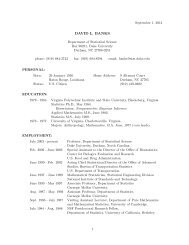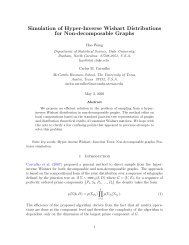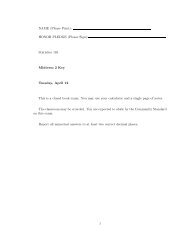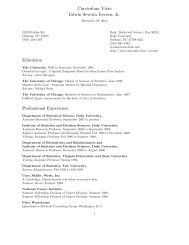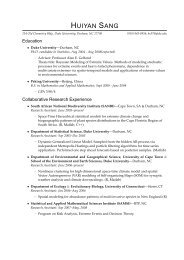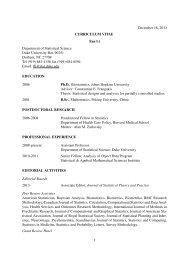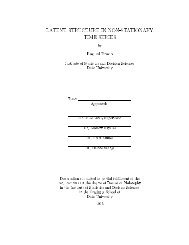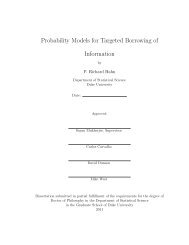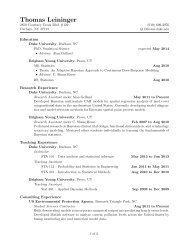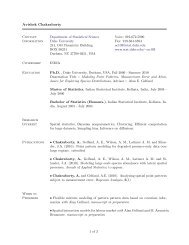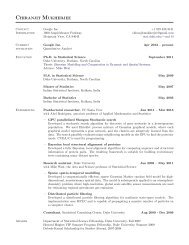Bayesian Dynamic Factor Models - Department of Statistical Science ...
Bayesian Dynamic Factor Models - Department of Statistical Science ...
Bayesian Dynamic Factor Models - Department of Statistical Science ...
Create successful ePaper yourself
Turn your PDF publications into a flip-book with our unique Google optimized e-Paper software.
1 Introduction<br />
<strong>Dynamic</strong> factor models have been widely developed in both methodological and practical issues,<br />
and become a standard tool for increasingly high-dimensional modelling <strong>of</strong> time series. In particu-<br />
lar, flexible and parsimonious innovation structures for underlying latent process such as stochastic<br />
volatility (Aguilar and West (2000)) and time-varying loadings (Lopes and Carvalho (2007)) make<br />
the factor models more flexible and reasonable to assess the complex multivariate time series. In<br />
application <strong>of</strong> such factor analysis, the latent time-varying loadings grow quickly in dimension with<br />
the number <strong>of</strong> time series response variables and the number <strong>of</strong> factors, which typically leads to<br />
increased uncertainty in estimation. Much progress has been recently made for sparse factor analy-<br />
sis (West 2003; Carvalho et al. 2008; Lopes et al. 2010; Yoshida and West 2010) using the sparsity<br />
priors for variable selection (George and McCulloch 1993, 1997; Clyde and George 2004); but<br />
these studies assume that the loadings are constant over time.<br />
This paper develops dynamic sparse factor models by embedding the latent threshold (LT)<br />
approach <strong>of</strong> Nakajima and West (2010); the time-varying loadings are thresholded to induce zero<br />
values adaptively. The idea is that some factor loadings are practically relevant in some time<br />
periods, but irrelevant or redundant in others. Nakajima and West (2010) propose latent threshold<br />
models (LTM), a general approach to dynamic sparsity modelling in time series and state-space<br />
models. The LTM structure allows time-varying parameters for non-zero values when supported<br />
by the data while collapses them fully to zero when redundant or irrelevant. This data-driven<br />
shrinkage mechanism induces dynamic sparsity in high-dimensional parameters that change over<br />
time. In the current paper, we design the time-varying loadings with the LTM structure to focus on<br />
relevances <strong>of</strong> factors to each time series response variable. The methodology is applied to real-data<br />
study using daily exchange rate returns. Our objectives <strong>of</strong> this empirical analysis are model fitting,<br />
forecasting and dynamic portfolio decisions, and reporting practical utility <strong>of</strong> our proposed models.<br />
In Section 2, we review the dynamic factor models with time-varying loadings and stochastic<br />
volatility. In Section 3, we generalize the factor models by embedding latent threshold modelling<br />
approach, and develop a <strong>Bayesian</strong> inference and MCMC algorithm. In Section 4, we apply our<br />
proposed models to six series <strong>of</strong> daily exchange rate returns. In Section 5, a portfolio allocation<br />
study is investigated. In Section 5, concluding comments are provided.<br />
Some notation: We use the distributional notation y ∼ N(a, A), d ∼ U(a, b), p ∼ B(a, b),<br />
v ∼ G(a, b), for the normal, uniform, beta, and gamma distributions, respectively. We also use,<br />
for example, N(y|a, A) to denote the actual density function f(y) when y ∼ N(a, A), in cases<br />
where the specificity is needed; and s : t stands for indices s, s + 1, . . . , t when s < t, for succinct<br />
subscripting such as in use <strong>of</strong> y 1:T to denote {y 1, . . . , y T }.<br />
2






